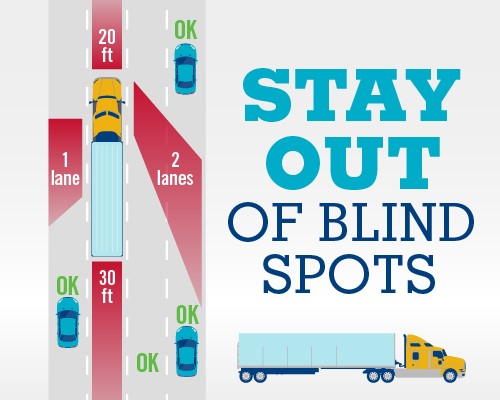Safe Driving Tips Around Tractor Trailers
Perhaps nothing is more nerve wracking while traveling than maneuvering around a large 18-wheeler or tractor trailer. That difficulty and anxiety is multiplied significantly when the ordinarily large 18-wheeler is larger than usual and is hauling what is commonly known as a wide or oversized load. There are special regulations in each state that apply to tractor trailers that are hauling these larger than normal loads that are intended to keep passengers safe. Any vehicles that seek to exceed the size and weight limits must apply for a permit from the Department of Transportation (DOT) and are labeled as a wide load.
Size and weight restrictions
As mentioned above, the regulations on wide loads vary by state. In West Virginia, a vehicle is not permitted to exceed eight (8) feet in width unless operated on a highway with a lane width of ten feet, at which time a vehicle width shall not exceed eight feet six inches (8’6”). The maximum height permitted on all roadways is thirteen feet six inches (13’6”). The maximum length depends on whether the trailer is fixed, or the vehicle is a semitrailer. The overall length of vehicles is not permitted to exceed seventy feet (70’) on any interstate or state routes and fifty-five (fifty) feet on local routes. Importantly, motor homes, travel trailers, truck campers and motor buses are excluded from these size limits. The gross vehicle weight limit without a special permit is 80,000 pounds for a tractor-trailer combination with five total axles.
Pilot cars with oversized load signage and amber lights are often required to safely escort loads that exceed the height, width, or weight restrictions.
Increased danger
There is good reason for these heightened safety regulations. A study from the University of Michigan Transportation Institute concluded that trucks that weigh 80,000 pounds or more are 50% more likely to be involved in the fatal crash compared to trucks that weigh less than 65,000 pounds. According to the Federal Motor Carrier Safety Administration (FMCSA) in 2017, 148,000 people were injured, and 4,761 people were killed in crashes involved large trucks, of which 3,289 involved tractor-trailers. The FMCSA defines a large truck as a vehicle with a gross vehicle weight rating more than 10,000 pounds. Most disturbing, 69% of fatal large truck accidents involved tractor-trailers, making these large vehicles some of the most dangerous vehicles on our roadways.
Increased stopping distance
The stopping time and distance for a tractor trailer is much greater than that of smaller vehicles. A fully loaded tractor trailer traveling at 65 MPH in good road conditions needs nearly two football fields to stop. This distance is even higher for tractor trailers that are hauling a load that exceeds the standard 80,000 pound weight.
Larger blind spots
Most folks are aware of the blind spots alongside tractor trailers; however, commercial vehicles have large blind spots around all four sides. As you can see in the diagram below published by the FMCSA, tractor trailers are surrounded by blind spots that each represent a road safety hazard. This danger can be increased significantly when a wide or oversized load is being hauled and the location of the blind spots may depend on the type and layout of the cargo.

Larger turn radius
Without question, another hidden danger of wide loads or oversize loads is the dramatic effect on the turn radius of the tractor trailer. It is especially important for drivers to be alert for tractor trailers that are turning right to avoid being caught in the “right turn squeeze” as the cab swings left for a wide right turn and available space is quickly filled by the trailer “squeezing” to the right. Again, these dangers are heightened when tractor trailers are traveling with a load that may be wider and taller than normal.
Moving Forward
In 2017, 10.8 billion tons of freight were moved by trucks in the United States and the industry will continue to grow as more consumer goods are ordered online and shipped directly to consumers. These large trucks, and occasional oversized loads, are going to remain a significant road safety hazard on our roadways. Please exercise appropriate caution while maneuvering around a tractor-trailer and be mindful of the four blind spots to keep your family safe during your travels.
Our experienced attorneys understand the laws and regulations that apply to the trucking industry. We are known for a blue-collar work ethic and a tireless effort of fighting for our client’s best interests. Remember that if disaster ever strikes for you or your family, the attorneys at Bailey Glasser are here when you need us most.